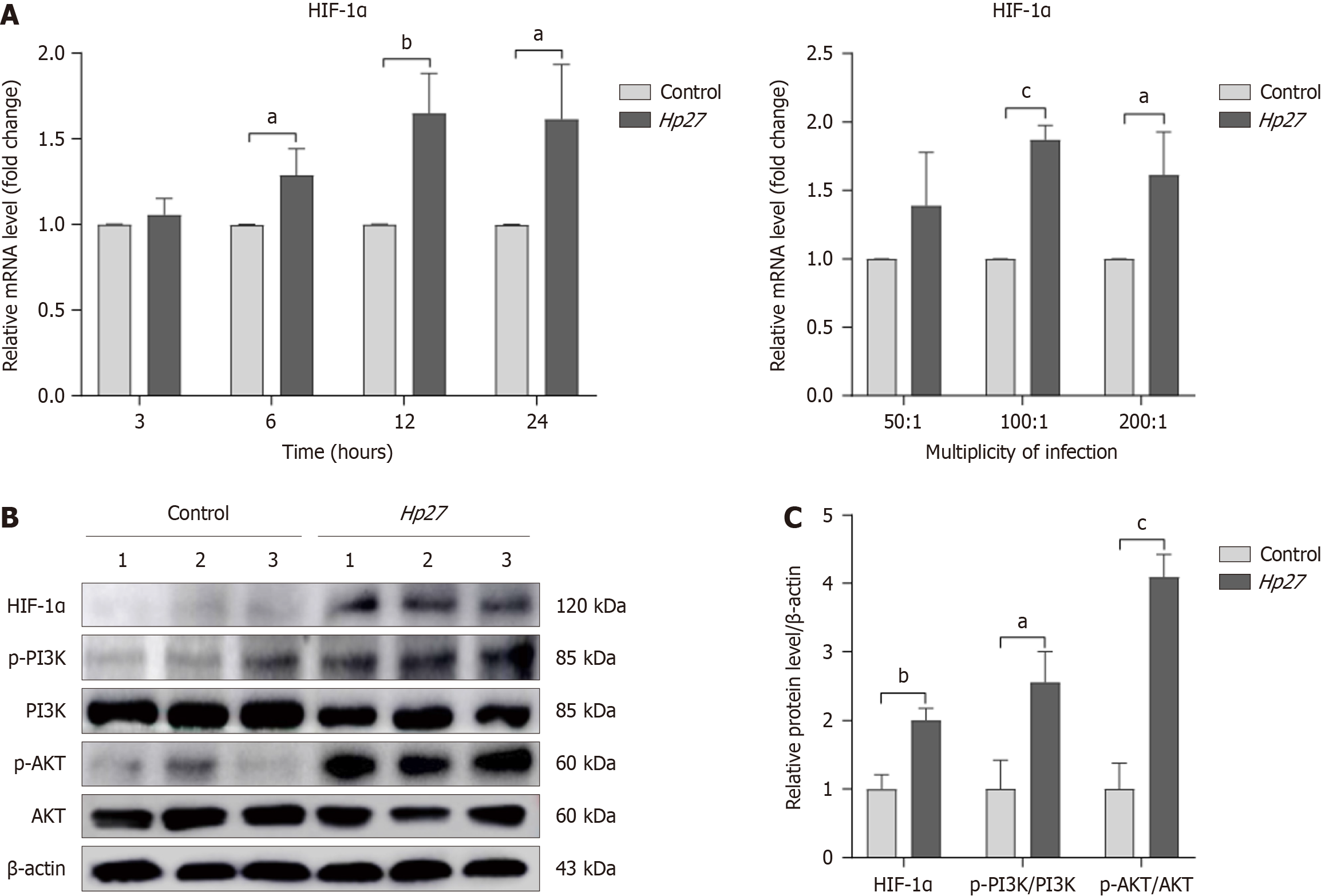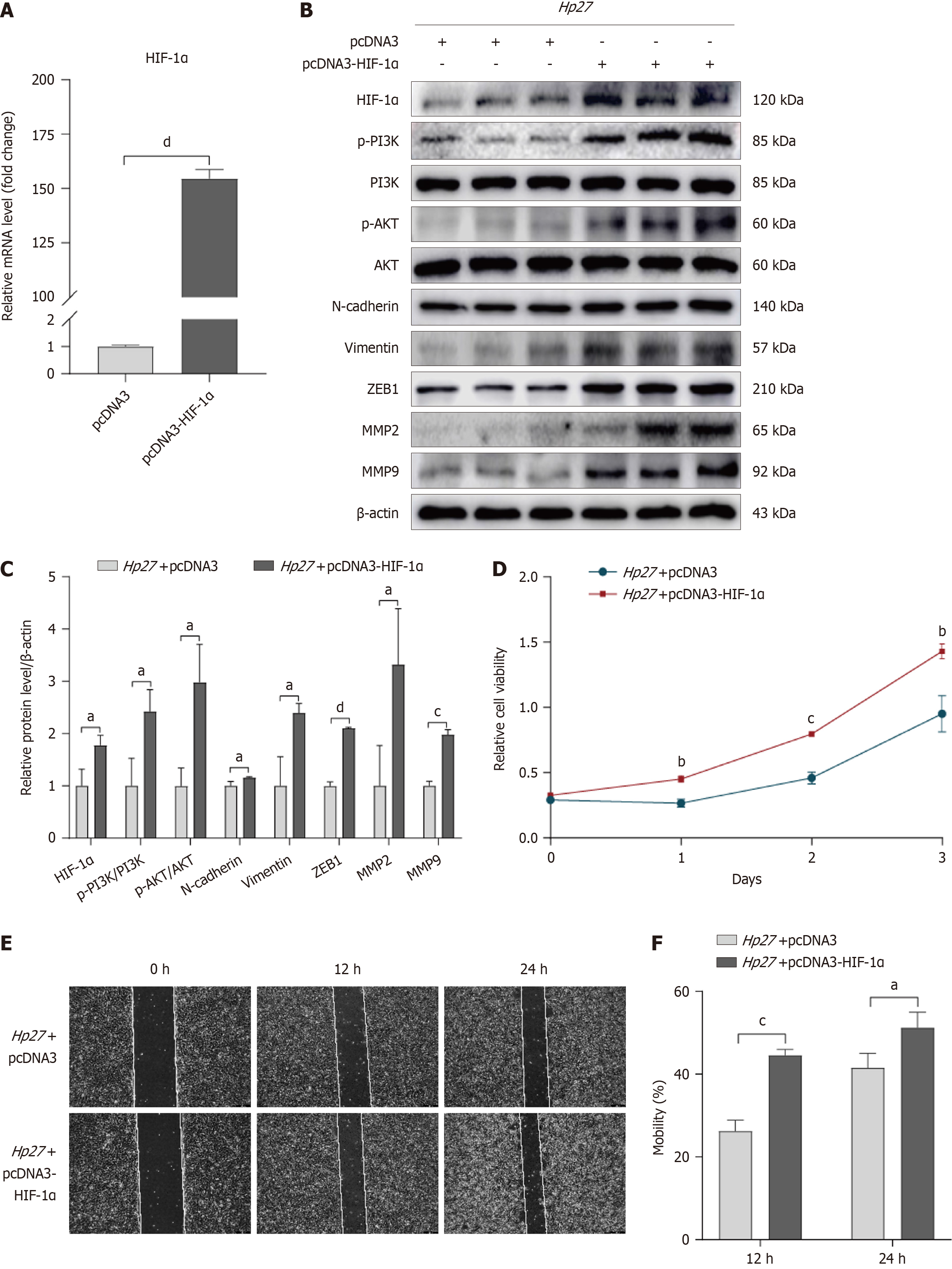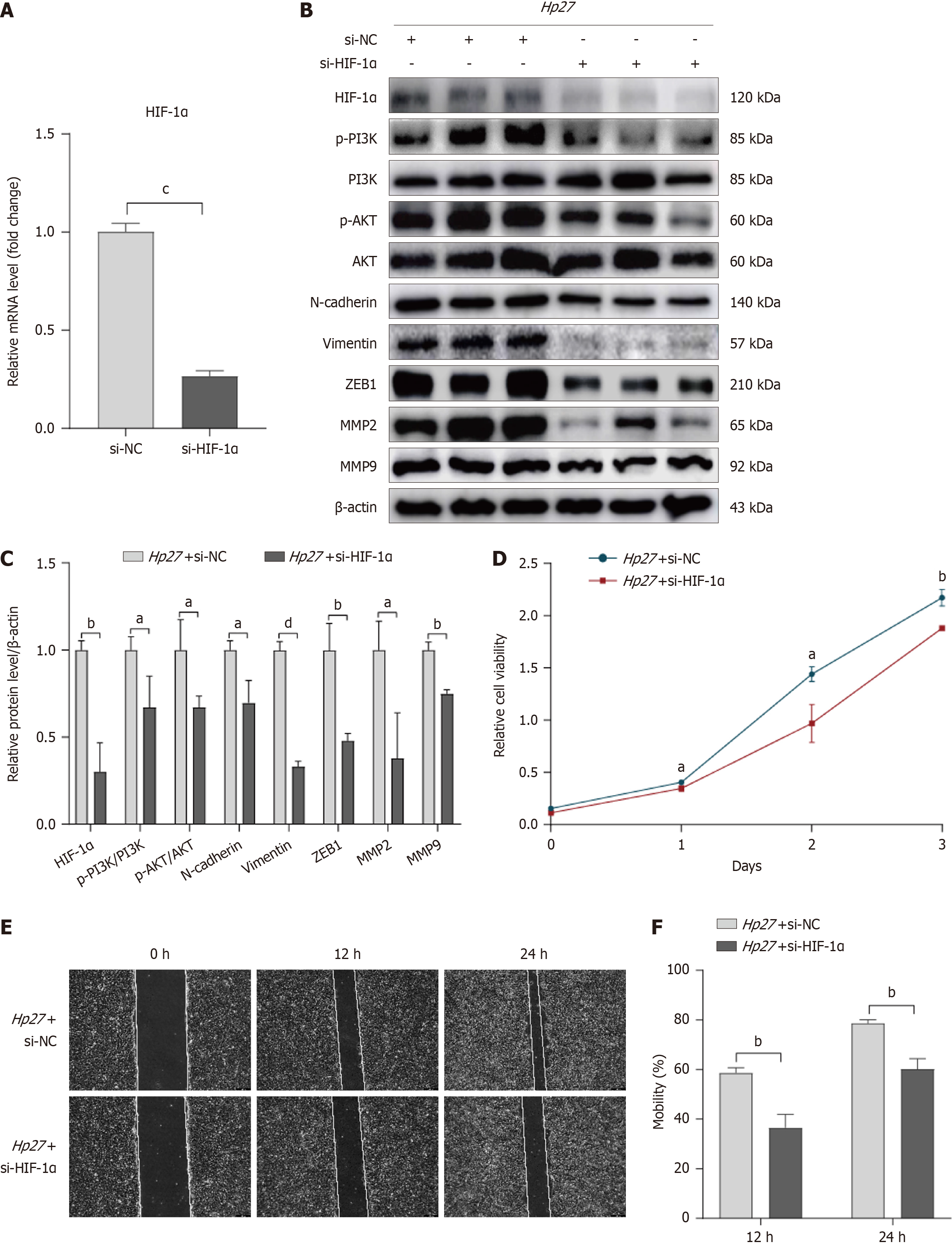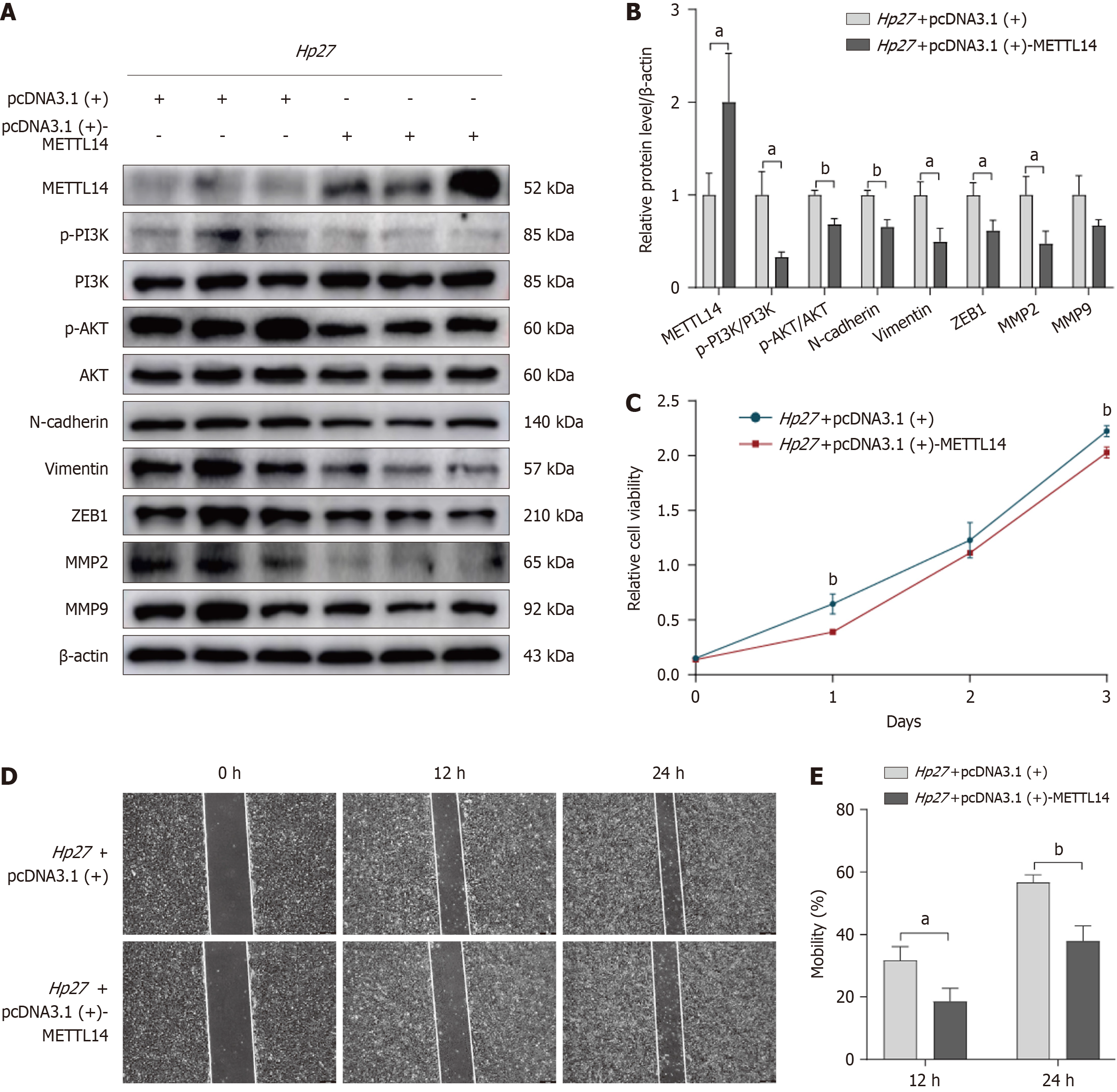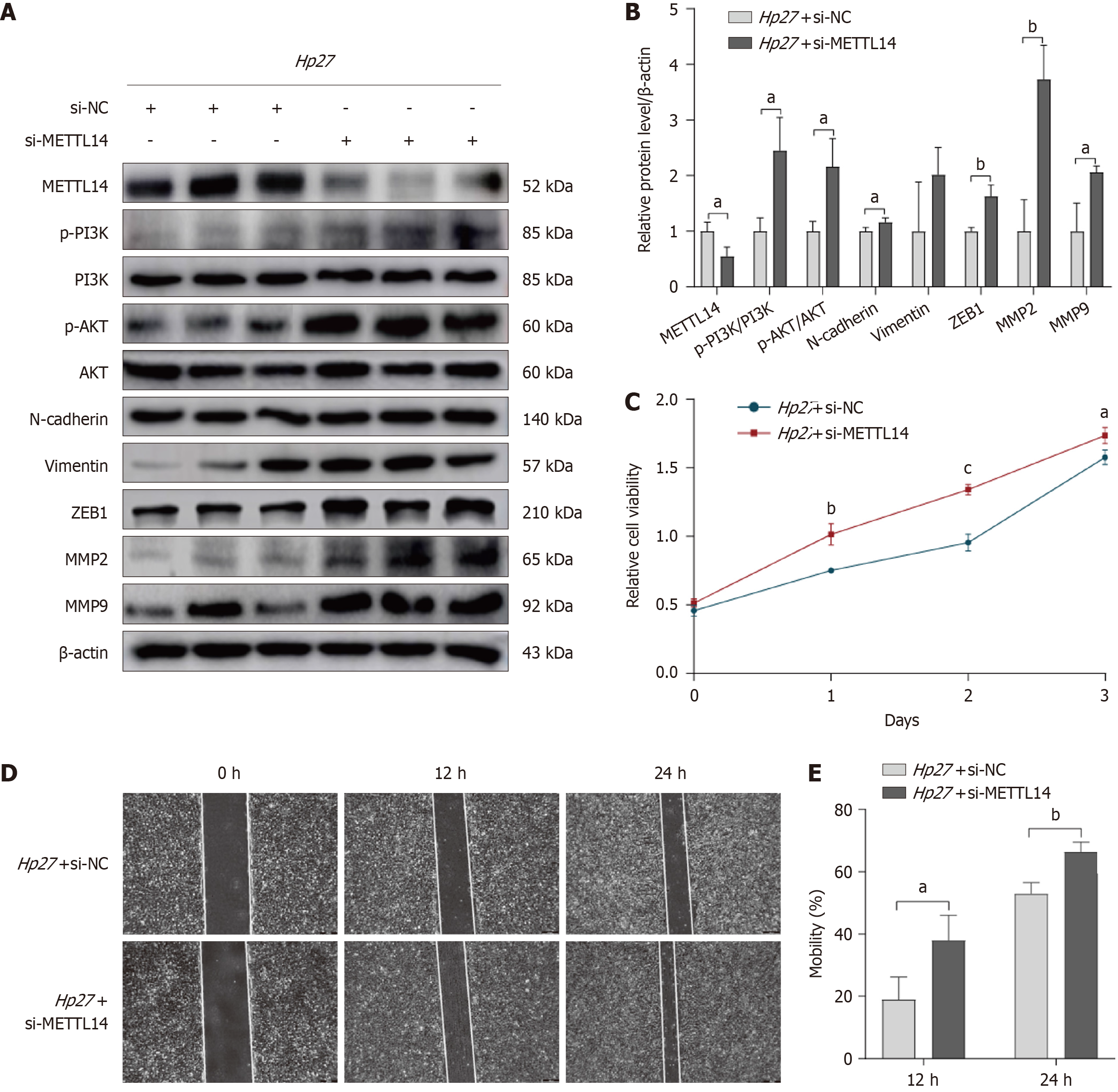Copyright
©The Author(s) 2024.
World J Gastrointest Oncol. Jul 15, 2024; 16(7): 3270-3283
Published online Jul 15, 2024. doi: 10.4251/wjgo.v16.i7.3270
Published online Jul 15, 2024. doi: 10.4251/wjgo.v16.i7.3270
Figure 1 Helicobacter pylori induces hypoxia-inducible factor-1α expression and activates the PI3K/AKT pathway.
A: Quantitative reverse transcription-polymerase chain reaction was performed to detect the relative mRNA level of hypoxia-inducible factor-1α (HIF-1α) at different infection time points (3 h, 6 h, 12 h, and 24 h) and multiplicity of infection (50, 100, and 200) in Helicobacter pylori-infected human gastric epithelial cells. β-actin was used as the internal reference; B and C: HIF-1α and PI3K/AKT pathway proteins were detected by Western blot analysis. β-actin was used as the internal reference. aP < 0.05, bP < 0.01, cP < 0.001, compared with control group. HIF-1α: Hypoxia-inducible factor-1α.
Figure 2 Hypoxia-inducible factor-1α overexpression promotes the activation of PI3K/AKT pathway and the malignant behaviors of cells.
A: Quantitative reverse transcription-polymerase chain reaction showed that hypoxia-inducible factor-1α (HIF-1α) plasmid was successfully transfected into gastric epithelial cells; B and C: Protein levels were analyzed by Western blot, including HIF-1α, p-PI3K, PI3K, p-AKT, AKT, N-cadherin, Vimentin, ZEB1, MMP2, and MMP9, all normalized to β-actin. These proteins respectively represented the PI3K/AKT pathway, epithelial-mesenchymal transition, and cell invasion ability; D: Cell counting kit-8 assay was utilized to evaluate cell viability; E and F: Wound healing assay was conducted to test the migration ability. aP < 0.05, bP < 0.01, cP < 0.001, dP < 0.0001, compared with pcDNA3 or Hp27 + pcDNA3 group. Hp27: H. pylori 27 strain; HIF-1α: Hypoxia-inducible factor-1α.
Figure 3 Knockdown of hypoxia-inducible factor-1α suppresses the PI3K/AKT pathway, epithelial-mesenchymal transition, and cell proliferation, migration, and invasion.
A: Quantitative reverse transcription-polymerase chain reaction showed that hypoxia-inducible factor-1α (HIF-1α) small interfering RNA (siRNA) was successfully transfected into gastric epithelial cells (GES-1); B and C: The transfected GES-1 cells were co-cultured with H. pylori and Western blot analysis revealed the changes of HIF-1α, p-PI3K, p-AKT, epithelial-mesenchymal transition biomarkers, and invasion indicators; D: Cell counting kit-8 reagent was added into the cells with corresponding treatment and the absorbance at 450 nm was recorded; E and F: Detection of migration rate by wound healing assay. aP < 0.05, bP < 0.01, cP < 0.001, dP < 0.0001, compared with siRNA-negative control (NC) or Hp27 + siRNA-NC group. siRNA-NC: Small interfering RNA-negative control; HIF-1α: Hypoxia-inducible factor-1α.
Figure 4 Methyltransferase-like protein 14 is downregulated by Helicobacter pylori and involved in hypoxia-inducible factor-1α expression.
A: Detection of primary m6A modifiers under Helicobacter pylori (H. pylori) infection; B: Methyltransferase-like protein 14 (METTL14) plasmid and METTL14 small interfering RNAs (siRNAs) were successfully transfected into gastric epithelial cells (GES-1) and the mRNA expression was determined by quantitative reverse transcription polymerase chain reaction; C: Actinomycin D experiment was performed to test the stability of hypoxia-inducible factor-1α (HIF-1α) mRNA at 0 h, 6 h, 12 h, and 24 h. remaining (%) = 6/12/24 h HIF-1α mRNA level/0 h HIF-1α mRNA level; D and E: The mRNA and protein levels of HIF-1α were detected in cells that were transiently transfected with pcDNA3.1(+)-METTL14 and infected with H. pylori; F and G: Transiently transfected siRNA-METTL14 cells were infected with H. pylori, and then the mRNA and protein levels of HIF-1α were detected; H: Immunofluorescence staining and confocal microscopy images of control and Hp27-infected GES-1 cells. Nuclei (blue), METTL14 (green), and HIF-1α (Red). Scale bars = 20 μm. aP < 0.05, bP < 0.01, cP < 0.001, dP < 0.0001, compared with pcDNA3.1(+) or Hp27 + pcDNA3.1(+), siRNA-NC or Hp27 + siRNA-NC group, all normalized to β-actin. siRNAs: Small interfering RNA; METTL14: Methyltransferase-like protein 14; HIF-1α: Hypoxia-inducible factor-1α; NC: Negative control.
Figure 5 Overexpression of methyltransferase-like protein 14 inhibits the activation of PI3K/AKT pathway and gastric cancer progression.
A and B: After methyltransferase-like protein 14 (METTL14) overexpression, the related protein levels were checked by Western blot, including METTL14, p-PI3K, PI3K, p-AKT, AKT, N-cadherin, Vimentin, ZEB1, MMP2, and MMP9, all normalized to β-actin; C: Cell viability was detected by cell counting kit-8 assay; D and E: Cell migration was detected by wound healing assay. aP < 0.05, bP < 0.01, compared with Hp27 + pcDNA3.1(+) group. METTL14: Methyltransferase-like protein 14.
Figure 6 Knockdown of methyltransferase-like protein 14 cells promotes the activation of PI3K/AKT pathway and gastric cancer pro
- Citation: An TY, Hu QM, Ni P, Hua YQ, Wang D, Duan GC, Chen SY, Jia B. N6-methyladenosine modification of hypoxia-inducible factor-1α regulates Helicobacter pylori-associated gastric cancer via the PI3K/AKT pathway. World J Gastrointest Oncol 2024; 16(7): 3270-3283
- URL: https://www.wjgnet.com/1948-5204/full/v16/i7/3270.htm
- DOI: https://dx.doi.org/10.4251/wjgo.v16.i7.3270









